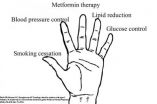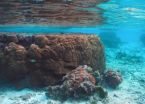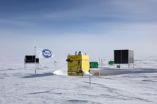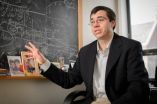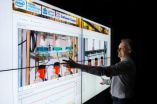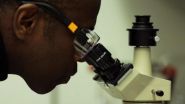(Press-News.org) Speed dating, in which potential lovers size each other up in brief 10 minute encounters before moving on to the next person, can be an awkward and time-wasting affair. Finding the perfect research partnership is often just as tough. Speed dating-style techniques are increasingly used at academics conferences, but can be equally frustrating - with busy academics being pushed into too many pointless encounters.
But now a group of scientists led by geneticist Rafael Carazo Salas have constructed a system that could revolutionise conference speed dating - by treating scientists like genes.
Using mathematical algorithms, the team created a method of matching conference-goers according to pre-set criteria, bringing about unforeseen collaboration opportunities while also enabling "would-like-to-meet" match-ups across disciplines and knowledge areas. The results have been recently published in the open-access journal eLife.
Funded by the Royal Society to run a small-scale satellite conference on cell polarity, the researchers wanted to find a way to not only break the ice between scientists who did not know each other, but also to "break the heat" - to encourage big name scientists to step outside of their usual small circle, and mix with up-and-coming scientists.
"We wanted to avoid the usual pattern that happens at conferences, especially at interdisciplinary meetings, of like sticking with like. Then we came up with an idea – what if we treated the delegates like we treat genes, and used mathematical algorithms to build a connectivity picture that could enable new links to be made?" said Carazo Salas, from the Gurdon Institute and Genetics Department of Cambridge University, who co-developed the technique with colleagues Federico Vaggi and Attila Csikasz-Nagy from Fondazione Edmund Mach, Italy.
In the lead-up to the conference, delegates were asked to submit information about their research areas and disciplines and also to come up with a 'wish list' of specialist areas that they would like to know more about.
"The conference started in a predictable way. After the first couple of talks, questions came entirely from people in the first few rows. We then did a brief presentation about the "speed dating" session that was about to happen. People's eyes lit up when they got the game – the notion of being treated like genes seemed to appeal."
In the first speed-dating round, the 40 delegates were each paired up with someone who was not known to them and who had a very different knowledge base – so someone specialising in X technique might be paired with a specialist in Y. Pairs were given around 10 minutes to talk and then moved on to new pairs, so that each person met a total of four other people they knew very little about.
"The atmosphere in the room after the first round of speed dating was entirely different. There was a buzz, and at the next set of talks questions came from all over the room, not just the usual couple of rows at the front".
In the second round, the pairings made use of the wish lists the delegates had created. The calculations, whilst making sure that the 'acquaintance distance' was still wide, this time worked on a would-like-to-meet basis: matching people with highly developed skills in a particular research method - such as intravital imaging, microfluidics or phenotype ontology - with those who wanted to learn about that method. The weighting system used in the calculations meant that overall the pairings were optimised to ensure that each pair was as close a match as possible.
"We knew it was risky, but the results were very successful. The delegates had conversations that would never have happened normally, and many came away with new collaboration possibilities that will hopefully broaden out the field."
The team are now hoping to fine tune their approach by testing it out in other situations – at conferences of varying sizes, and in other disciplines. The computational algorithm could be adapted to handle larger scales (for example, a higher number of participants) or a higher number of requirements (for example, including the degree of seniority or geographical location).
INFORMATION: END
Meet your match: Using algorithms to spark collaboration between scientists
2014-02-20
ELSE PRESS RELEASES FROM THIS DATE:
Editorial illustrates shift away from glycemic control in diabetes treatment
2014-02-20
BOSTON (February 20, 2014)—An editorial in a February issue of American Family Physician proposes a simple way for physicians to communicate with patients about the best treatments for diabetes. The "lending a hand" illustration reprioritizes treatment goals, based on research on mortality reduction, to convey that glycemic control is no longer the primary intervention.
In order of benefit, to improve length and quality of life, patients with type 2 diabetes benefit from these interventions, starting with smoking cessation:
"Glycemic control is stuck in people's minds ...
Why are some children more resilient to post-traumatic stress?
2014-02-20
New Rochelle, NY, February 20, 2014—Children exhibit a range of responses to traumatic events such as natural disasters, with some suffering acute traumatic reactions that resolve over time and others experiencing long-term symptoms of post-traumatic stress. Identifying factors that may help predict which youths are at greater risk of more serious disorders and which are likely to be more resilient following a traumatic event can help determine the care and services needed, according to an article in Journal of Child and Adolescent Psychopharmacology (JCAP), a peer-reviewed ...
What is El Nino Taimasa?
2014-02-20
During very strong El Niño events, sea level drops abruptly in the tropical western Pacific and tides remain below normal for up to a year in the South Pacific, especially around Samoa. The Samoans call the wet stench of coral die-offs arising from the low sea levels "taimasa" (pronounced [kai' ma'sa]). Studying the climate effects of this particular variation of El Niño and how it may change in the future is a team of scientists at the International Pacific Research Center, University of Hawai'i at Mānoa and at the University of New South Wales, Australia.
Two El ...
Remote Antarctic telescope reveals gas cloud where stars are born
2014-02-20
Using a telescope installed at the driest place on earth - Ridge A in Antarctica – a UNSW-led team of researchers has identified a giant gas cloud which appears to be in an early stage of formation.
Giant clouds of molecular gas – the most massive objects in our galaxy – are the birthplaces of stars.
"This newly discovered gas cloud is shaped like a very long filament, about 200 light years in extent and ten light years across, with a mass about 50,000 times that of our sun," says team leader, Professor Michael Burton, an astronomer at UNSW Australia.
"The evidence suggests ...
With friends like these, who needs democracy?
2014-02-20
EAST LANSING, Mich. — From Ethiopia to Nicaragua, countries that go through civil war are much less likely to become democratic if the winning side gets help from rival nations, a Michigan State University political scientist argues.
In a new study examining democratization after civil wars since World War II, Michael Colaresi found the majority of groups that eventually took power failed to establish democratic governments if those groups took money or weapons from a foreign enemy during the war.
Receiving such aid can create mistrust among the nation's citizens and ...
Sustainable use of energy wood resources shows potential in North-West Russia
2014-02-20
Nowadays, humanity faces many challenges; the most serious are poverty, the growing demand for resources and the deterioration of the environment. In order to satisfy the growing demand for wood, forestry in many countries has to be intensified. The forests of the Russian Federation are the world's largest reserve of wood for different purposes. Intensification of forestry in Russia will result in increasing availability of wood for material and energy uses.
A doctoral dissertation completed at the University of Eastern Finland analysed the potential of energy wood resources ...
From a distance: New technique for repair work
2014-02-20
This news release is available in German.
Numerous German companies are operating globally these days: They develop products domestically, but production is done in other countries like China, Brazil or the Czech Republic. If maintenance or repair work is needed, the engineers who had designed the complex production plants frequently have to travel from Germany.
A novel approach by computer scientists in the research group of professor Thorsten Herfet from the Chair of Telecommunications at Saarland University could provide a solution: a platform that brings together ...
Researching Facebook business
2014-02-20
Establishing and maintaining relationships online is becoming ever more important in the expanding global knowledge economy. But what happens to the relationship between business and consumer when a user "unfriends"? Writing in the International Journal of the Business Environment, Christopher Sibona and Steven Walczak of The Business School, at the University of Colorado Denver, USA, have found that there are many online and offline reasons why a person might "unfriend" another party.
The team has examined these factors and offer insights into how virtual business relationships ...
Gathering the clues to rare gene variants contributing to schizophrenia
2014-02-20
Philadelphia, PA, February 20, 2014 – Schizophrenia has long been known to be highly heritable and is present in approximately 1% of the population. Researchers have been following two paths in their pursuit of identifying schizophrenia risk genes.
Initially, they studied common gene variants that, individually, only increase the risk for schizophrenia by a few percent, perhaps increasing the likelihood of developing schizophrenia from a 10 out of a 1000 chance to an 11 or 12 out of a 1000 chance.
More recently, research has identified gene variants that are rare in ...
Spotlighting black chemists and chemical engineers (video)
2014-02-20
WASHINGTON, Feb. 20, 2014 — Their research may lead to a new generation of renewable fuels, medical devices and safer home products. The American Chemical Society (ACS) is continuing its celebration of Black History Month with a new video featuring several African-American chemists and chemical engineers doing cutting edge research today. The video is available at http://youtu.be/v0PmKbJNAQI.
The video, produced with the National Organization for the Professional Advancement of Black Chemists and Chemical Engineers (NOBCChE), highlights the efforts of Kristala Prather, ...
